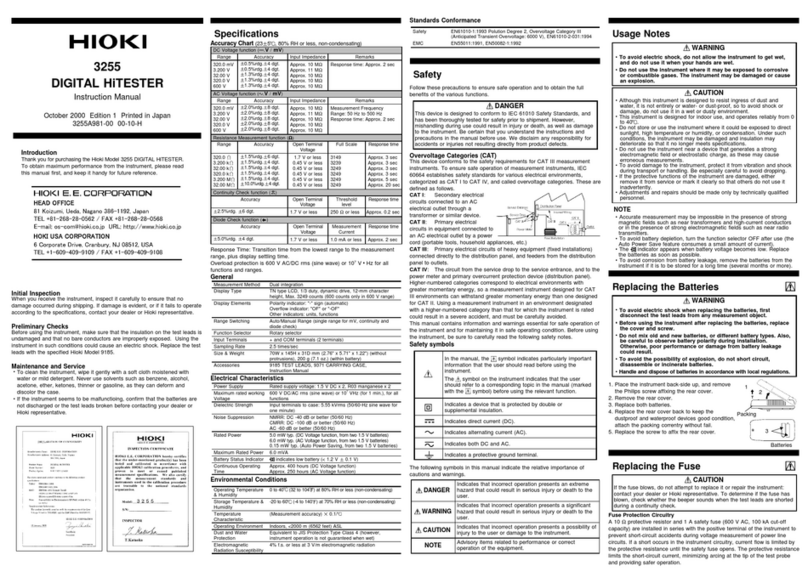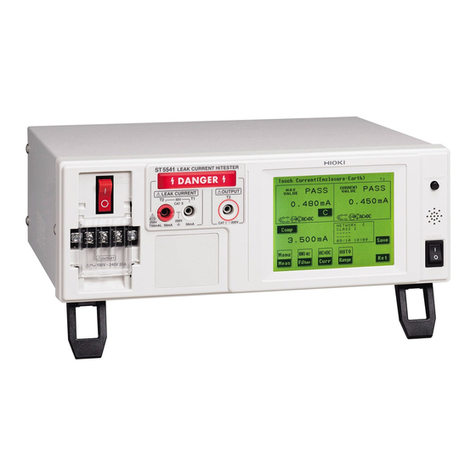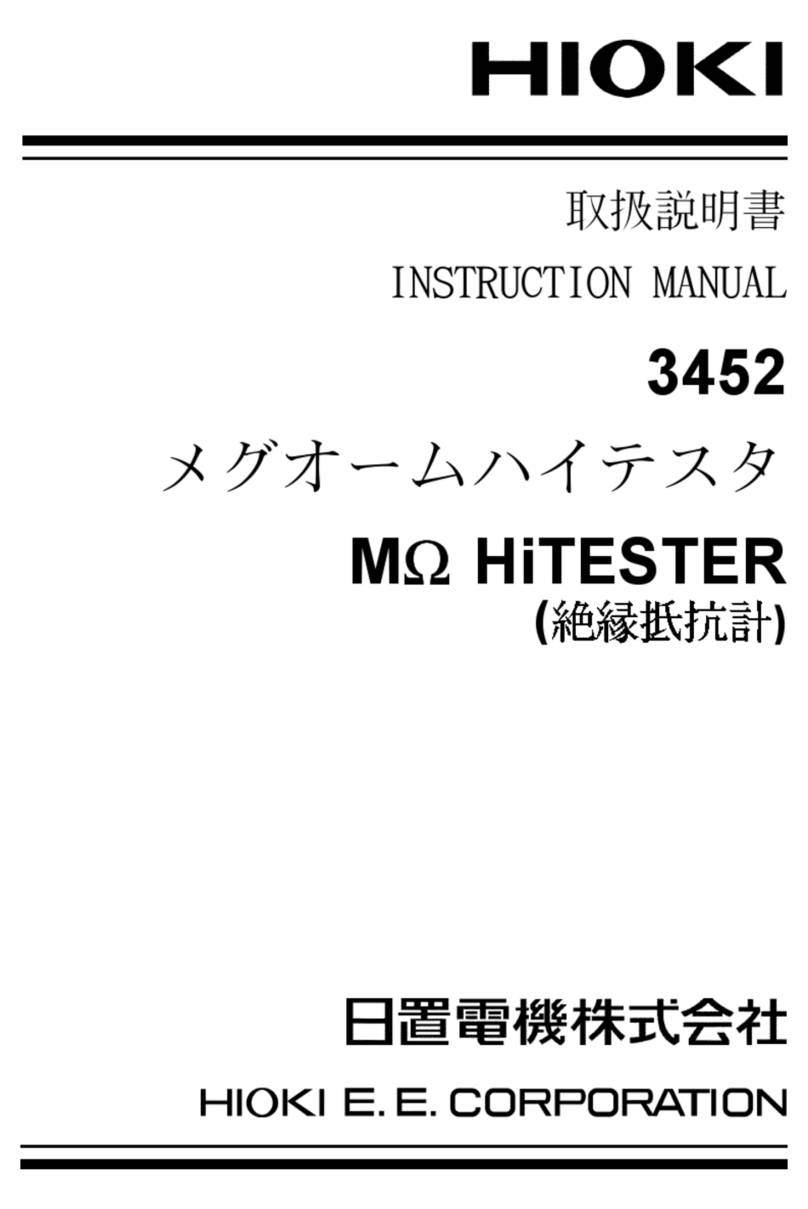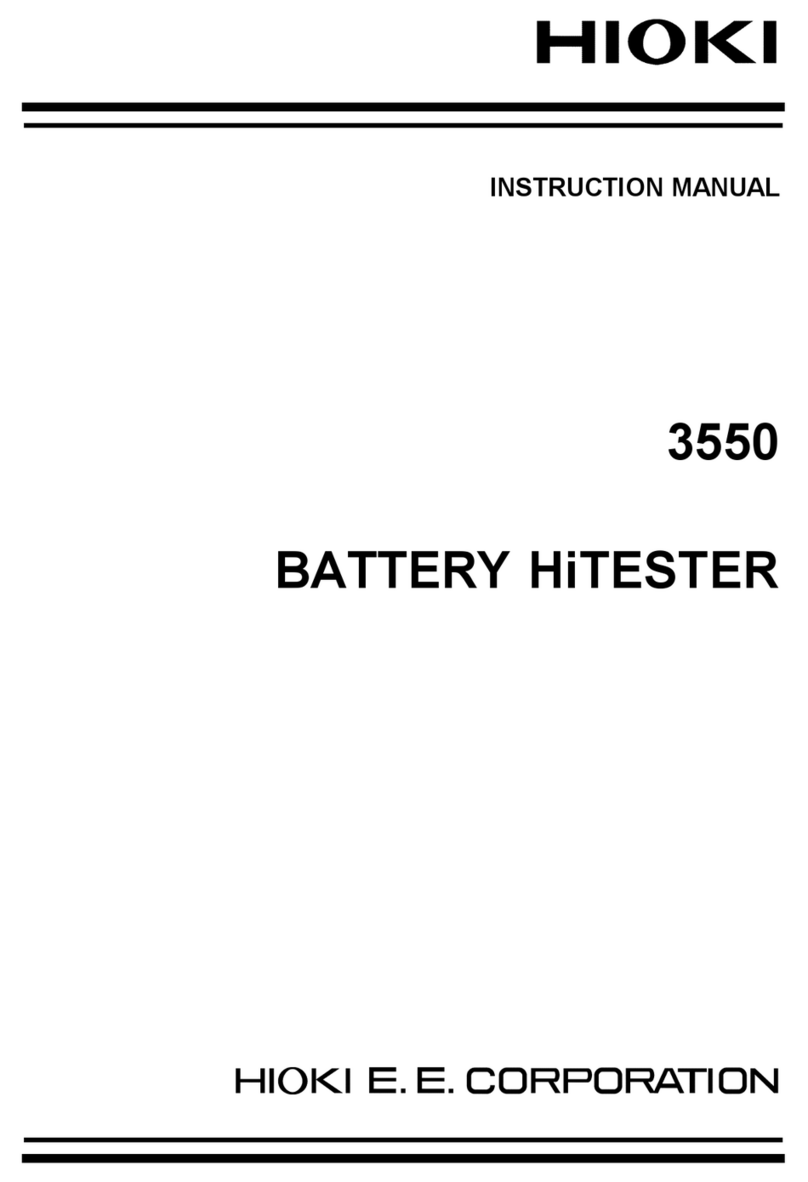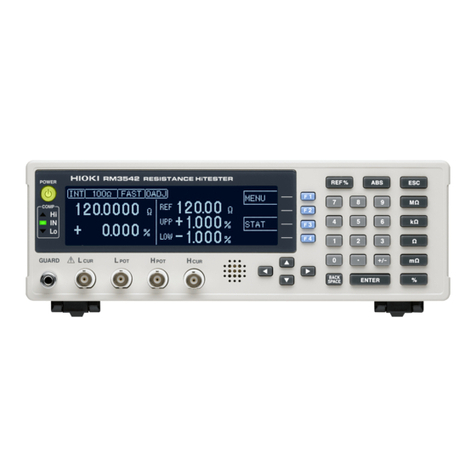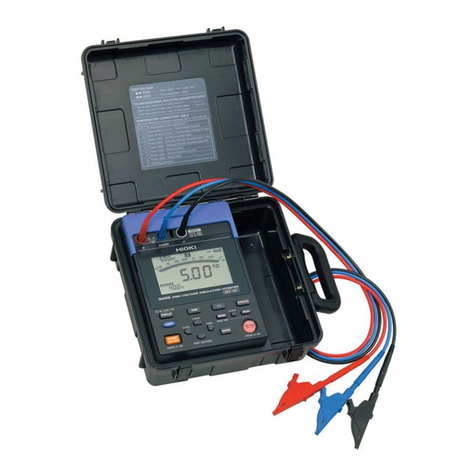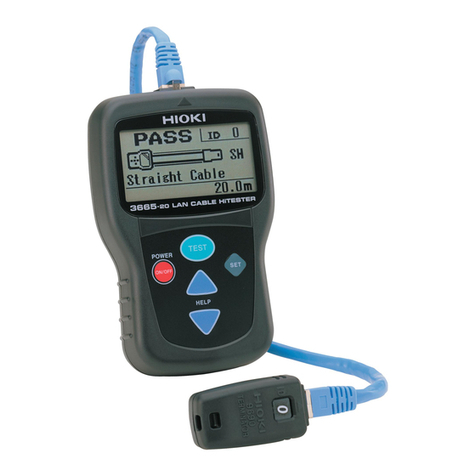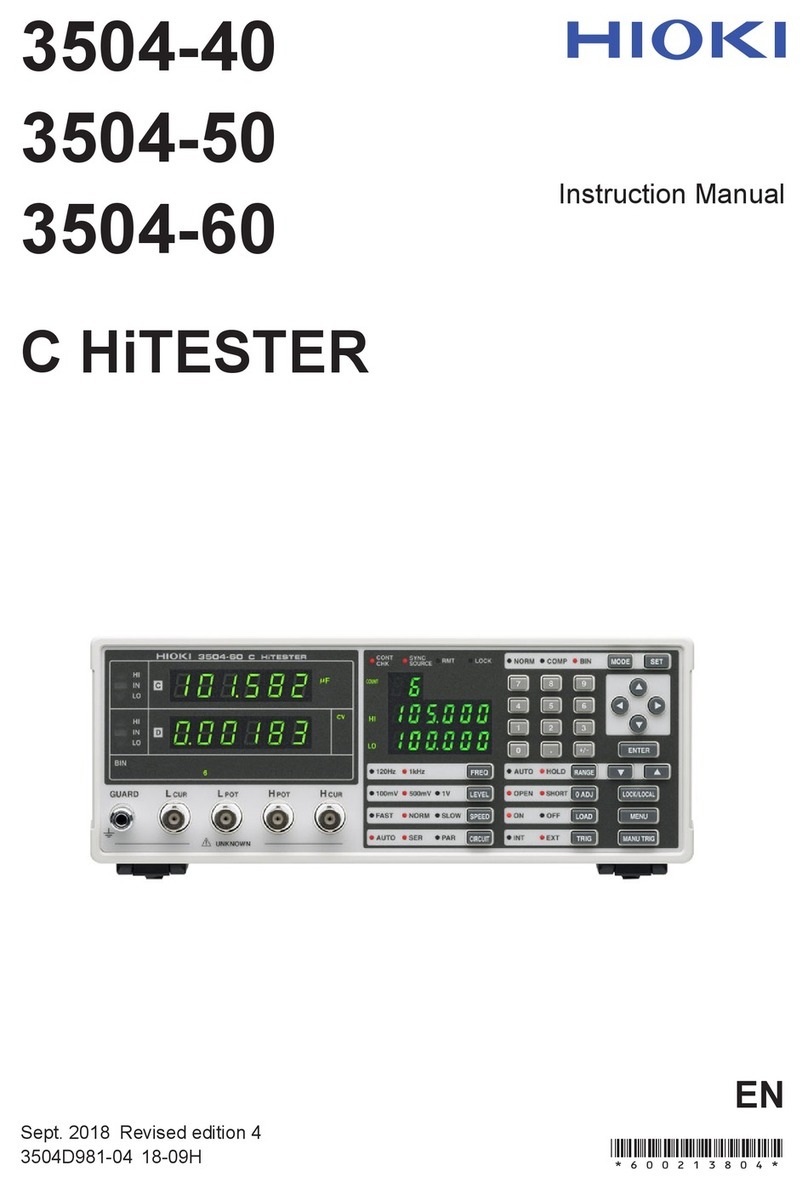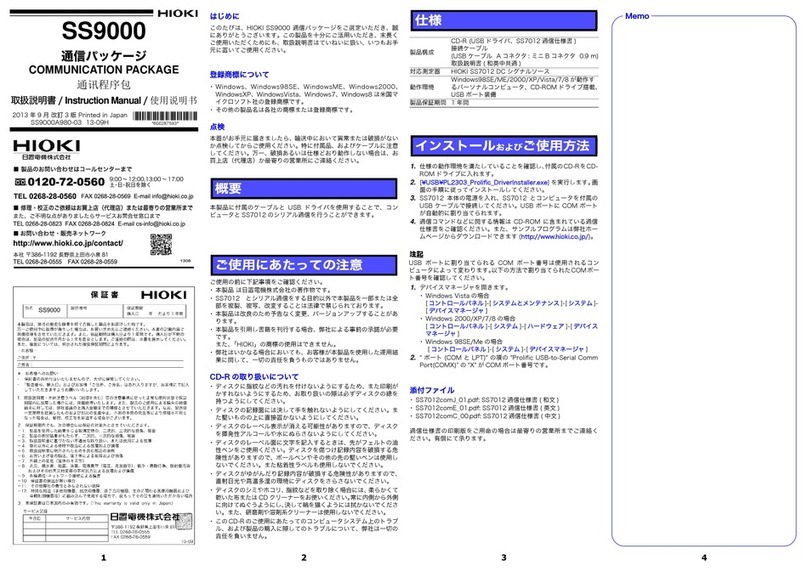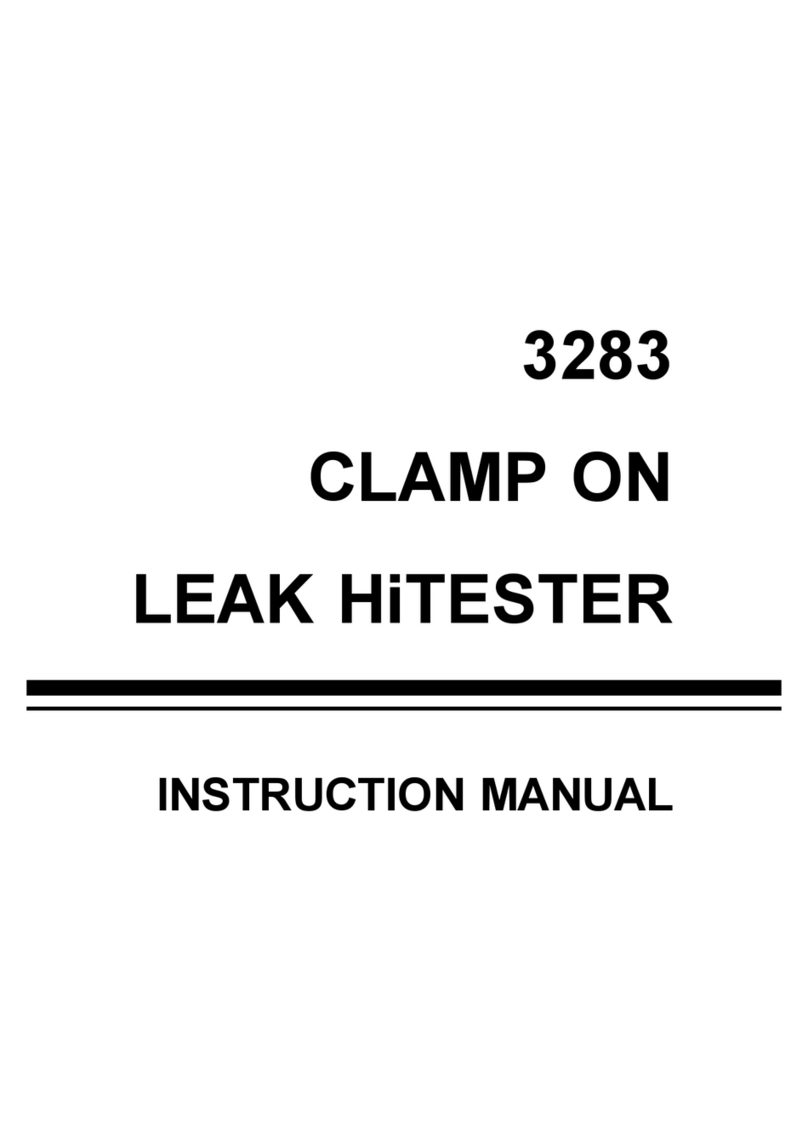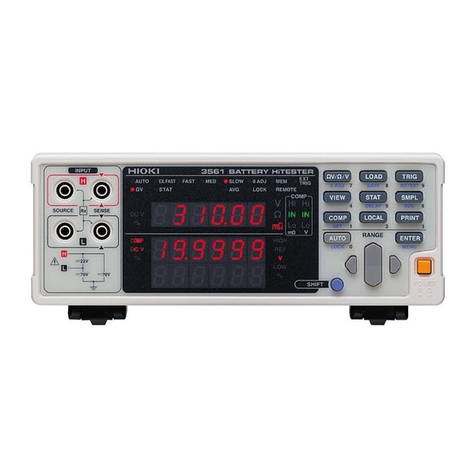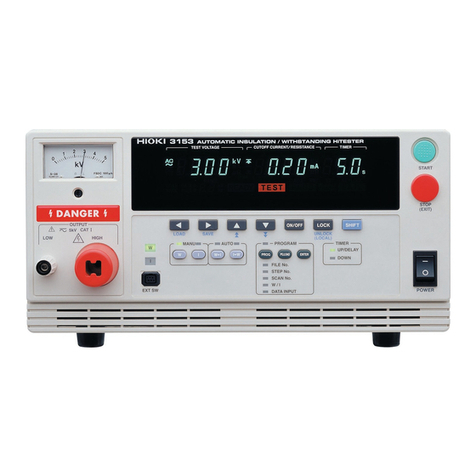
Storage temperature
range -10 to 50 (14 to 122 ) (no condensation)
Power source Rated power voltage 9 VDC
6F22 layer-built manganese battery x 1
Maximum rated
power 100 mVA
Battery lifetime Approx. 45 hours (continuous, no load)
External dimensions
and mass Approx. 62W x 216.5H x 39D mm, Approx. 350 g (3281)
Approx. 2.44"W x 8.58"H x 1.54"D, Approx. 12.3 oz. (3281)
Approx. 62W x 231H x 39D mm, Approx. 400 g (3282)
Approx. 2.44"W x 9.06"H x 1.54"D, Approx. 14.1 oz. (3282)
Names and Functions of Parts
Voltagae and resistance
input terminals
3281(600 A)3282(1000 A)
Jaw
Lever
Key switches
Display (LCD)
Back casing
(back)
Alternating current
AUTO
SLO
REC
MAX
MIN
AVE
Auto-ranging
Display update:
approx. once per three seconds
Record function
Maximum value
Minimum value
Average value = (maximum value
+ minimum value) / 2
min
hour
HOLD
APS
*
*
Ω,kΩ
One minute: one segment (bar
graph)
One hour: one segment (bar
graph)
Data hold
Auto power-off
Centigrade
Fahrenheit
Resistance
Continuity
Hz
V
A
RMS
PEAK
C.F.
Frequency
Voltage
Current
True RMS value
Peak value
Crest factor = Peak value /
Effective value
Input over (bar graph)
Battery consumption warning
Measurement Procedure
Preparation
Fresh battery
Battery capacity 0 " " light.
Beep tone sounds 3 timeshe battery
condition.
Measurements taken at this battery level
is not guaranteed for accuracy.
AC current (ACA) measurement A
OK
SLOW PEAK C.F. RMS
Wave
form Peak
ine
ave Peak
Triangular
wave Peak
C.F. 1.41 1.73 1
Hz RMS
AC voltage measurement V
Black Red
Plug in the test leads
Resistance measurement
Black Red
Plug in the test leads
Continuity check
Data hold function HOLD
Auto power-off function APS
Battery consumption warning
Buzzer
FAST mode
Recording function REC
MAX MIN AVE Instantaneous value
(No display)
Battery Replacement Procedure
WARNING
When replacing the battery, be sure to insert it with the correct polarity.
Otherwise, poor performance or damage from battery leakage could result.
Replace battery only with the specified type.
CAUTION
Do not fix the back casing screws too tightly.
The torque about 0.5N・m is recommended.
Battery holder
How to Attach the Hand Strap
Troubleshooting
Symptom Battery Battery snap Test leads
The instrument cannot be
powered on. -
Power is cut off immediately
after it is turned on.*- -
"" lights. - -
The instrument is powered
off during operation.*-
Voltage measurement does
not function. - -
Resistance measurement
does not function. - -
Remedy:
If the trouble cannot be
remedied, send the
instrument for repair.
Replace with a
new battery. The terminals of
the battery snap
are poorly
contact.
Check the test
leads wiring.
An indication E.001 to E.005 appears. Send the instrument for repair.
Service
3. Accessories
Model L9207-10 Test Lead (black and red set), Instruction manual, Model 9399 Carrying
Case, Hand strap, 6F22 (006P) battery
*: Temperature probes have been discontinued.
The temperature measurement function is no longer available.
1. Remove the rear cover and insert a battery. (Refer to Battery Replacement Procedure.)
2. Press POWER to turn the unit on. Verify that all segments of the isplay light up briefly.
Then the model name is shown, and the bar graph indicates the battery condition.
3. The AC current measurement mode is activated.
Low battery voltage detection function
After the mark lights and battery voltage drops below a certain level, the power goes
off automatically. When this occurs, bAtt and Lo are displayed.
When power goes off after display of these marks, replace the exhausted battery with a
new one.
1. Press the key.
2. Clamp only one of the conductors and
place it in the center of the jaw.
The effective value (RMS) of the current is
displayed in the digital display and bar
graph.
A suitable measurement range is selected
automatically (AUTO).
NOTE
Use data hold function when you abolish indication and want to read it.
Please note that waveforms that include elements outside the frequency characteristic
range may not be measured correctly.
Current measurements exceeding 600 A AC should be of short duration. Heat builds
up in the jaw proportionate to the current value, and will reach a dangerous level over
a long period of time.
The unit cannot read zero with no input at low temperature. Even then, the accuracy is
guaranteed when a current of 3 A or more is measured.
Range selection
Press the RANGE key repeatedly cycles through the 30 A, 300 A, 600 A (1000 A) and
AUTO ranges.
Changing the display update SLOW
When the readings fluctuate and are difficult to take, it is possible to make the display
update slow (approx. once per three seconds), and the readings easy to take. The
screen-updating speed cannot be changed for the bar-graph display.
Pressing the SLOW/PEAK key repeatedly changes the display as follows.
Peak value display PEAK
The peak value is displayed. The effective value is displayed in the bar graph.
NOTE
Mode displaying the PEAK (peak value) of a continuous wave which lasts for more
than 250 ms.
To keep the displayed value, use the recording function in the PEAK display mode
(refer to recording function REC 1.).
As there is a period whereby no sampling is done on this instrument, it may not be
possible to measure an instantaneous peak current that does not reach 250 ms, such
as the motor starting current, even when the recording function is used.
To accurately measure an instantaneous peak current such as an inrush current,
please use HIOKI CM4371 and CM4373.
Crest factor display C.F.
The crest factor (peak-to-rms ratio) of a
waveform is displayed.
Crest factor = Peak value / Effective value
The crest factor of an undistorted sine wave
is 1.41.
A crest factor of other than 1.41 indicates
that a waveform is distorted, i.e., contains
harmonic components.
When a crest factor of current is displayed,
the indicator "A" flashes.
The effective value is displayed in the bar graph.
Frequency display Hz
1. Press the Hz key.
2. Pressing the Hz key changes the display as shown in the figure.
3. The frequency of the current being measured is displayed.
When no input is applied, "----" is displayed. When measuring the current frequency,
"A" flashes. The effective value is displayed in the bar graph.
NOTE
When the frequency is lower than 30 Hz, "----" is displayed.
The AUTO range display indicates the current range.
1. Press the key.
2. The effective value (RMS) of voltage is displayed in
the digital display and bar graph.
The display update changing, and the peak value,
crest factor and frequency displays are possible as
well as in the AC current measurement.
NOTE
Be sure to use the test leads with the sleeves
attached when performing measurements in the CAT
III and CAT IV measurement categories. In the
CATII environment, if the tips of the test leads do not
reach the measurement object, remove the rigid insulating sleeve before measuring.
Please note that waveforms that include elements outside the frequency characteristic
range may not be measured correctly.
1. Insert the test leads in the instrument as shown in
the figure.
2. Attach or remove the rigid insulating sleeve as
required by the measurement object.
3. Press the Ω//TEMP key to display Ω, changes the
display as follows.
Ω* *
(Centigrade) (Fahrenheit)
*: Temperature probes have been discontinued.
The temperature measurement function is no longer available.
4.The resistance value is displayed in the digital display and bar graph. Ranging is
automatic (AUTO).
NOTE
If a voltage is input, a warning beep will sound. Stop measurement immediately. (The
internal circuit is protected against up to AC 600 V.)
In some cases, the alarm does not beep for DC or DC weighted components.
1. Display " " in the same way as in the resistance measurement.
2. The buzzer beeps at less than approximately 30 Ω, and " " flashes.
NOTE
The digital display indicates the measured resistance value.
If a voltage is input, a warning beep will sound. Stop measurement immediately. (The
internal circuit is protected against up to AC 600 V.)
In some cases, the alarm does not beep for DC or DC weighted components.
Data hold functions to "stop" the display at its present reading.
Press the HOLD key. "HOLD" appears, and the digital and bar graph displays are
held. This function is effective for all measurement functions and modes.
To release this function, press the HOLD key again.
When "APS" is being displayed, the auto power-off function is effective.
The unit is powered off in approx. 10 minutes unless any key is pressed.
"APS" flashes and the alarm beeps for approx. 30 seconds just before the unit is
powered off.
Pressing a key other than the POWER key prolongs the auto power-off function for 10
minutes.
To release the auto power-off function, press the POWER key while holding down the
HOLD key to power on the unit. In this case, "APS" does not appear.
When using the record function, the auto power-off function is ineffective.
If is indicated, the battery power is running low and accuracy cannot be guaranteed.
Replace with a new battery. Refer to "Preparation" for the confirmation of the capacity of
the battery.
To turn off the buzzer, press the POWER key while holding down the RANGE key to
power on the instrument. The alarm and continuity buzzers cannot be turned off.
Make it FAST mode when you measure load currents with variations.
The digital display update can be set to approx. 4 times per second.
1. Press the key twice to set to the FAST mode.
"F" appears for an instance, and the unit enters the FAST mode.
Then "F" appears each time the or key is pressed.
2. Press the RANGE key to fix the current range.
3. It is convenient for taking readings to hold the maximum value (MAX) by using the
record function.
4. To release the FAST mode, press the key twice again.
NOTE
The stable measurement cannot be made unless the waveform lasts for more than
250 ms.
Press the key in the case of the voltage measurement as well after it is made FAST
mode.
This mode is not effective for the resistance, continuity and temperature
measurements.
If setting to the SLOW display in the FAST mode, the display update is the same as
in the normal mode (approx. twice per second).
Use the recording function to hold the maximum and minimum measured values and
maximum/minimum averages.
1. Measurement indicated value
Pressing the MAX/MIN key during measurements of current, voltage, or frequency
activates the recording function. REC flashes and the instrument saves the
maximum value (MAX), minimum value (MIN), and average value (AVE) in internal
memory from the instant you press the MAX/MIN key. Pressing the MAX/MIN key
with the recording function activated switches the display as shown below. If MAX,
MIN, or AVE is not displayed, an instantaneous value is displayed.
Data (MAX, MIN, AVE) remains saved while the display is switched. If maximum or
minimum data is updated in the meantime, however, the data values will change.
With the recording function activated, the auto power-off function remains disabled.
(APS off.)
The average value (AVE) displayed is calculated by: Average Value = [(Maximum
value + Minimum Value)/2].
After pressing the SLOW/PEAK key to display the peak value, activate the recording
function and select MAX. The peak hold function will be activated.
2. Display of Elapsed Time
When you press the MAX/MIN key to activate the recording function, the bar graph
segments flash and the elapsed time appears.
When "min" is shown in the right-hand corner of the bar graph, each segment of the
bar graph corresponds to one minute. Every time one minute elapses, one segment
of the flashing bar graph goes on. When all segments of the bar graph go on, the
elapsed time is 30 minutes.
When the elapsed time exceeds 30 minutes, one segment of the flashing bar graph
goes off every time one minute elapses.
When the segments left of a flashing segment remain on: the number of "on"
segments represents the elapsed time (0 to 29).
The illustration below shows when 20 minutes have elapsed:
When the segments right of a flashing segment remain on: the number of "off"
segments (+30) represents the elapsed time (30 to 59).
The illustration below shows when 50 minutes have elapsed:
When digital display switches the average value (AVE) to a instantaneous value when
you press the MAX/MIN key, the right corner of the bar graph indicates hours. In this
mode, each segment of the bar graph corresponds to one hour. The way to read the
bar graph here is similar to reading it in minutes. When all bar graph segments
remain on, the elapsed time is 30 hours.
The illustration below shows when one hour, 40 minutes have elapsed.
3. Deactivation of Recording Function
Pressing the HOLD key deactivates the recording function. HOLD goes on, REC
stops flashing and goes on, and the elapsed time stops incrementing.
While the recording function is being deactivated, data are not updated, even if the
jaw is disconnected from the conductor.
Pressing the HOLD key again cancels HOLD display and activates the recording
function again, with REC flashing again.
4. Cancellation and Resetting of Recording Function
To cancel the recording function, press the related function key (A, V or Hz) for the
measurement in progress. Once the recording function is canceled, the auto power-
off function becomes effective. (APS goes on.)
To restart the unit after resetting the data, temporarily cancel the recording function,
then activate it again by pressing the MAX/MIN key.
Note
An instantaneous power failure and a surge cannot be detected.
The recording function is not effective for the resistance and temperature
measurements.
Use the recording function after having confirmed a battery residual quantity.
(Shown on the bar graph at power on.)
The lowest possible frequency that can be displayed is 30 Hz.
If changing the range when "O.L." is being displayed in any of the displays, the held
data and elapsed time are cleared.
Activate the recording function during measurement to obtain minimum value or
average value data. If the function is activated with no input, the minimum value will
remain zero. To deactivate the recording function, press the HOLD key first, and then
terminate the measurement. If you disconnect the jaw or test lead from the circuit
under measurement without deactivating the recording function beforehand, the
minimum value will be zero.
When the unit is turned off, accumulated data are lost.
1. Remove the two fastening screws of the rear cover,using a
Phillips screwdriver.
2. Remove the rear cover.
3. Remove the old battery without pulling the codes of the
snap.
4. Attach the new battery onto the battery snaps, paying
attention to the polarity, and then install the battery in the
battery holder.
5. Fasten the rear cover.
6. Screw in the fastening screws to fasten the rear cover.
Note
A 6LR61 battery is also usable.
Each of positive and negative terminals of nine-volt layered-
type dry batteries differ slightly in shape and size according
manufactures and types. When attaching the battery onto the battery snap, you may
notice them fastened each together tightly or loosely. Even then, the instrument will work
if the battery with the battery snap attached is installed properly in the battery holder.
The hand strap improves the operation.
Although the instrument seems to be out of order in the following cases, there may be
the causes of the troubles. Check it again before you send it for repair.
*:When the battery is drained, the relay may be operated immediately after the power
is turned on or when the measurement function is changed, and the power may
suddenly be cut off. Replace the battery with a new one when this arises.
To clean the instrument, wipe it gently with a soft cloth moistened with water or mild
detergent. Never use solvents such as benzene, alcohol, acetone, ether, ketones,
thinners or gasoline, as they can deform and discolor the case.
The shortest period for possession of the repair parts is 5 years after stopping the
production.
For inquiries about service, contact your dealer or Hioki representative.
Pack the instrument carefully so that it will not be damaged during shipment, and
include a detailed written description of the problem. Hioki cannot be responsible for
damage that occurs during shipment.
